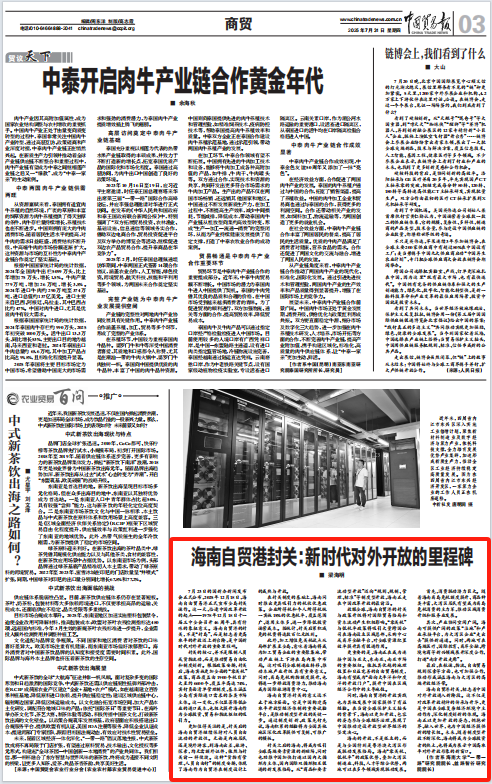On July 23, the State Council Information Office officially announced that Hainan Free Trade Port (FTP) will launch island-wide independent customs operations on December 18, 2025. This date holds profound symbolic significance, coinciding with the 46th anniversary of the Third Plenary Session of the 11th CPC Central Committee in 1978—a pivotal moment in China’s reform and opening-up journey. Rather than sealing off the island, the independent customs operation signifies a major step toward higher-level opening-up and represents a landmark achievement in China’s efforts to build a modern and open economic system in the new era.
The essence of the island-wide independent customs operation lies not in restricting the flow of goods or people, but in further advancing trade liberalization and institutional innovation. Under the new policy framework, Hainan will implement a more comprehensive zero-tariff policy, expanding the scope of zero-tariff coverage from 1,900 to around 6,600 tariff items, representing approximately 74% of all tariff lines. Imports will be regulated under a negative list approach, effectively covering nearly all types of market entities across the island with actual import needs. This policy shift will not only significantly reduce import costs for businesses, but also greatly enhance Hainan’s appeal as a global hub for investment, trade, and logistics.
Notably, following the launch of independent customs operations, the Hainan FTP will continue to ensure the free and convenient movement of people. No additional documents will be required for mainland residents or international travelers visiting the island for business, tourism, or family purposes. This institutional design—characterized by a regulated flow of goods and the free movement of people—demonstrates the maturity, openness, and inclusiveness of the Hainan FTP framework.
Building on the customs framework, Hainan will also roll out highly competitive tax incentives. A unified 15% preferential tax rate will apply to both corporate and individual income, with broad eligibility and extensive applicability. This will further reduce operational costs and encourage business formation. It is estimated that the cumulative value of tax reductions and exemptions following the customs closure will reach hundreds of billions of yuan.
Another important policy shift is the expansion of the tariff exemption program for processed goods. Previously limited to select areas, the policy will now be implemented across the entire island, positioning Hainan as a major hub for processing trade. This move is expected to drive the concentration of upstream and downstream industries within the island, supporting industrial upgrading. Meanwhile, the increase in offshore duty-free shopping quotas will further boost consumption and accelerate Hainan’s development into an international tourism and consumption center.
The significance of Hainan’s independent customs operations extends well beyond the local level.It serves as a critical pilot zone for institutional opening-up and a cornerstone in China’s efforts to build a high-standard open economic system. Through institutional innovation and pilot policy implementation, the experience accumulated in Hainan will serve as a replicable and scalable model for deepening reform in other regions of the country.
In this context, following the launch of independent customs operations, Hainan is expected to become a new magnet for high-end global resources and production factors, while contributing to China’s transition toward a new development paradigm featuring domestic circulation as the mainstay and mutually reinforcing flows between domestic and international markets. This marks a shift from opening up based on the flow of goods and production factors to institutional opening-up, focusing on rules, regulations, management, and standards—placing Hainan at the forefront of China’s reform and opening-up.
Globally, Hainan’s customs and policy transformation will have far-reaching implications for international trade patterns and capital flows. Its zero-tariff and low-tax environment will encourage multinational corporations to set up regional headquarters, procurement centers, and offshore financial platforms, thereby improving the efficiency of global resource allocation.
In particular, Hainan’s strategic location enables it to emerge as a key hub linking China with Asia-Pacific, Southeast Asian, and South Asian markets. With its geographical advantage and increasingly liberalized trade policies, the province is poised to become a gateway for China’s opening-up to the Pacific and Indian Oceans, strengthening China’s leadership role in regional economic cooperation.
Moreover, the opening-up practices of the Hainan FTP offer valuable experience for other developing countries. At a time when global protectionism is on the rise, Hainan is participating in global economic governance with greater openness and inclusiveness—demonstrating China’s firm commitment to building an open world economy.
Hainan’s development is not unfolding in isolation but is closely integrated with the rest of China, particularly the Guangdong-Hong Kong-Macao Greater Bay Area (GBA). Leveraging Hainan’s zero-tariff, low-tax policies and the GBA’s strengths in advanced manufacturing, technology, and human capital, the two regions are well-positioned to pursue synergistic development across a wide range of sectors.
First, the potential for consumption-driven integration is immense. With expanded offshore duty-free quotas and a wider range of goods, GBA residents are expected to become primary consumers in Hainan’s duty-free market—driving upgrades in regional consumption and service sectors.
Second, there is broad potential for industrial synergy. Hainan’s favorable policy environment and industrial capacity make it an ideal platform for GBA enterprises seeking international expansion. The two regions can deepen cooperation in emerging sectors such as high-end healthcare, international education, offshore finance, and cross-border e-commerce—jointly forging a “Southern Corridor of Opening-Up.”
Finally, enhanced cooperation in shipping, logistics, and free trade rule-making will further advance the building of a high-level open economic belt connecting Hainan and the GBA.
Taken together, the official launch of island-wide independent customs operation at the Hainan FTP marks a new phase in China’s reform and opening-up. It signifies not only a continuation and elevation of that legacy but also China’s proactive push for institutional innovation amid a complex global economic environment.With a more open posture, Hainan is accelerating its integration into the global economy, emerging as a new growth engine for China. As institutional opening-up deepens, Hainan is poised to become both a magnet for global investors and a new window into China’s high-standard openness to the world.

Translated by Li Xiang
Proofread by Xie Gengquan